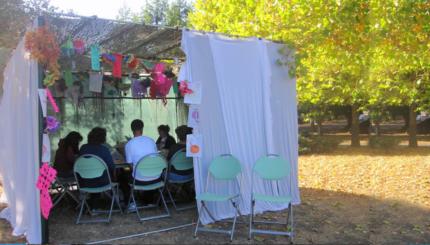Just before Sukkot began, news came out of a prominent Conservative rabbi who came out to his congregation as gay. His dignified letter to his community spread far beyond: to the wider Jewish community, and even to the mainstream press. The responses varied—some musing on the historicity of such announcements, some dwelling on the difficulty and complexity of his situation—and a few very ugly attacks (I decided not to link to any of them—they can be found if you wish to search for them).
This past week, with the advent of Sukkot, we turn away from dwelling solely on what we have done wrong, and hope that our amends have been accepted. Although we won’t know until Hoshana Rabbah (at the end of Sukkot) whether our apologies have been accepted, we still sit in joy in our sukkot. We invite in the ushpizin—the kabbalistic archetypes of Jewish values of chesed (loving kindness), gevurah (power), tiferet (beauty), nezah (endurance), hod (glory), yesod (foundation), and malchut (majesty), symbolized by various Jewish ancestors who embodied those traits.
The very first of those—Abraham and Sarah—represent chesed, and we are reminded of the midrash of their tent, which stood open on four sides, so that all would feel welcome. We think of the midrash about the four minim—the myrtle, the willow, the palm and the etrog (citron), which we bind and hold together on sukkot because every part of the Jewish community is necessary for any of us to achieve redemption.
We still have not fully achieved that divine trait of chesed in the Jewish community. We have not yet fully been able to welcome all—our tent is not yet open on four sides – but we are getting there, slowly. This past year has seen a seismic shift in American attitudes -and laws- towards marriage equality, and the Jewish community has been a part of that. It’s a small step towards a more comprehensive need to accept one another, not just in marriage, but that there should be no one who fears for their job if they come out—regardless of what profession they are in; no one should fear to be who they are, ever.
The responses that we have seen last week show how far we have to go, and how much work is yet to do, but there is also hope. We are rolling up our sleeves to roll up the sides of our tent. We sit in our fragile huts , looking up at the stars.
Sukkot
Pronounced: sue-KOTE, or SOOH-kuss (oo as in book), Origin: Hebrew, a harvest festival in which Jews eat inside temporary huts, falls in the Jewish month of Tishrei, which usually coincides with September or October.


